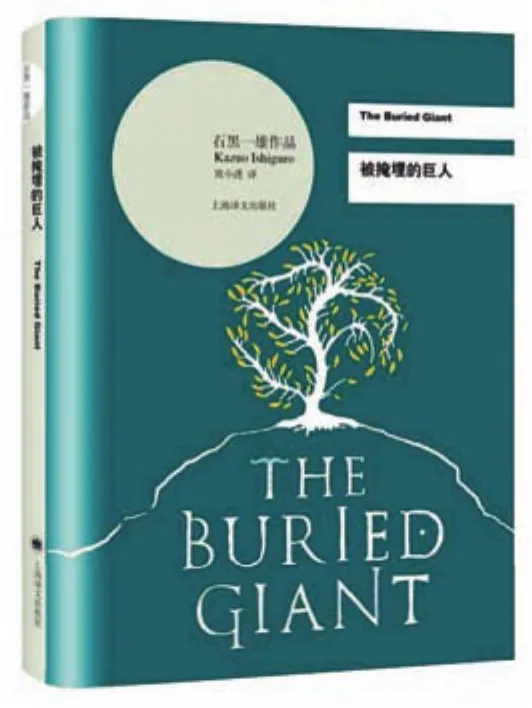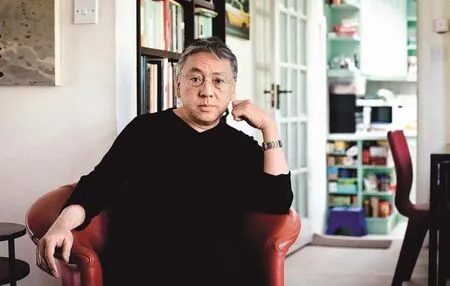如何“挖掘”被掩埋的巨人
◇ 文|田 东
如何“挖掘”被掩埋的巨人

这个国庆小长假,得知今年诺贝尔文学奖颁给了日裔英国作家石黑一雄。颁奖词这样描述他的作品:石黑一雄的小说富有激情的力量,在我们与世界连为一体的幻觉下,他展现了一道深渊。这个1982年走上文坛的男人,迄今为止发表了七部长篇小说,算不上高产。其中最近的一部、2015年3月推出的《被掩埋的巨人》引发了热议。有国外媒体称它“颠覆了西方奇幻文学既定模式”。中国读者对石黑一雄的文学地位和成就向来是认同的,不过,不同于对《远山淡影》《浮世画家》《别让我走》等作品的评价,《被掩埋的巨人》招致了各种风评。
我很好奇,它到底是个好故事还是“失败之作”。有意思的是,读完后发现,这部小说带来的阅读乐趣和书名一样,被作者布下的重重迷雾所深深掩埋,在他展现的那道“深渊”里。
On October 5th, 2017, news came that Kazuo Ishiguro, a Japanese-British writer, was awarded the Nobel Prize in Literature. He was described by the Swedish Academy as a writer "who, in novels of great emotional force, has uncovered the abyss beneath our illusory sense of connection with the world". Having started his literary career in 1982, he has published seven novels so far, and the latest one, The Buried Giant in March 2015, which was referred to as having overturned the existing pattern of Western fantasy literature, has triggered heated discussions. Despite their affections for the author and his previous works, Chinese readers have made controversial comments on The Buried Giant.
With its success doubted by some, I have read the book, only to understand the pleasure of reading it is only buried by the mist the author created in the “abyss” he uncovered.
掩埋者的精彩与失败
Achievements and Setbacks of the Author
表面上,我所看到的评价不怎么宽容:有的认为石黑一雄力图拓展写作类型和推进写作技巧的野心使得小说叙事稍显堆砌,一定程度上损失了阅读的魅力,成了“观念”的容器;有的指出,《被掩埋的巨人》或许是作者最不给力的作品,不精彩,读不下去,甚至是“石黑一雄的失败之作”。
在熬了两个夜读完小说、参考了十几篇石黑一雄的访谈和作品评论后,一个结论越来越清晰——《被掩埋的巨人》并不失败,当然也谈不上不精彩,只是被掩埋起来了,需要挖掘。
“巨人”掩埋者石黑一雄,1954年出生于日本,五六岁时随父母移民英国,是当代最受瞩目的英国小说家之一,与鲁西迪、奈保尔一起并称为“英国文坛移民三雄”。他最早以其含蓄、婉约的笔触和跨越种族和文化的国际主义的小说著称,从上世纪80年代开始在英国文坛走红以来,他一直受到国际重要文学奖项的青睐——
1989年,他凭小说《长日留痕》拿下当年的布克奖;1995年,获得英国皇家协会的文学骑士勋章(OBE)和法国艺术文学的骑士勋章;2005年,小说《别让我走》被《泰晤士报》列入1923年以来百部最伟大英语小说;2008年,他被《泰晤士报》列为“1945年以来英国最伟大的50位作家”之一。
在成为一名职业作家之前,石黑一雄曾试图从事音乐事业,还一度在美国西海岸游历(你也可以理解为漂泊),就在写出成名作《远山淡影》前后,他还在英国一家电视台从事编剧工作。或许这些经历使得他的小说时空跨度十分多元化,从战后的日本到上世纪三十年代的上海,从日暮西山的伦敦到未来的虚构城市。现在,“掩埋巨人”的时空,则是公元六世纪的英格兰……
I have seen bad reviews of the book: some claim Ishiguro to have made the work a container of “concepts” by piling up materials due to his ambition to enrich the styles and skills of his writing; others contend it is not attractive enough for them to continue, criticizing it as a failure of Ishiguro.
After reading, I referred to interviews and reviews of Kazuo Ishiguro himself, and that is how I got the conclusion mentioned above: The Buried Giant is anything but a failure, though its charm is buried and needs digging up.
Kazuo Ishiguro, who buried the “giant”, was born in Japan in 1954 and moved with his family to England around fi ve. Recognized as one of the three most prominent immigrant writers, together with Rushdie and Naipaul, he is one of the most celebrated contemporary novelists in England. Noted for his books with internationalism crossing ethnics and cultures and his implicit and graceful style, he has won many signi fi cant international literary awards since 1980s.
In 1989, he won the Booker Prize for his novel The Remains of the Day; the year of 1995 saw him become Officer of the Order of the British Empire and gain Chevalier de l'Ordre des Arts et des Lettres; in 2005, The Times named Never Let Me Go one of the 100 greatest English language novels since 1923; The Times ranked Kazuo Ishiguro among their list of "The 50 Greatest British Writers Since 1945" in 2008.
Ishiguro was once engaged in music before his literary career, and he traveled (or roved) along US West Coast. Besides, he once worked as a screenwriter in England as well. Life experience enriched the settings of his writing, ranging from post-war Japan to Shanghai in 1930s, or from falling London to fi ctional future cities. Now, “the burying of the giant” took place in Britain in the 6th century...
掩埋的方式到底有多少
Ways to Bury
公元六世纪的英格兰,不列颠人与撒克逊入侵者的战争似乎走到了终点,两个族群相安无事地生活了数十年。与此同时,一片奇怪的“遗忘之雾”萦绕着英格兰的山谷,吞噬着村民们的记忆,生活好似一场毫无意义的白日梦。一对年迈的不列颠夫妇想要赶在记忆完全丧失前找到儿子,踏上了艰辛的旅程。他们渴望迷雾散去,重拾相伴一生的恩爱回忆。但迷雾掩盖的却是一个黑暗血腥的过去。记忆与宽恕,复仇与和平,人物的命运不可避免地交织在了一处……

事实上,小说的故事性也被“掩埋”了,这源于作者对语言模糊性特质的熟练处理,和他“偷师”自马塞尔•普鲁斯特的“运动的方法”,即事件与场景的顺序并不遵循时间的需要,亦不跟随某个线性线索展开,而是依靠切线式的联想或记忆中的奇想,推动小说从一个部分过渡到另一个部分。
据说,作者从开始动笔到最终出版,一共改了11稿,每一次改动,都让“掩埋”巨人的方式有所变动。
首先,借助“运动的方法”,叙述角度就多次被变换:第一部前三章以埃克索为叙述人,从第四章叙述人变成了小男孩埃德温,而后又打乱叙述角度,第三部出现了绿衣骑士高文的第一人称,还出现了全能的“上帝视角”;最后一章,作者直接跳出来做了叙述人。
这种转换也构成“迷雾”的一部分,多元叙事空间既丰富了作品的阅读美感,也不可避免地提高了理解的门槛。
不仅如此,书中多次出现了电影里的闪回场景,更模糊了时空的边界,让人雾里看花。比如,绿衣骑士高文的回忆,撒克逊男孩埃德温对母亲的追忆,还有被绑住双手的小女孩突然出现,以及埃克索和比特丽丝夫妇那些并不清晰的过去等等。“掩埋”巨人的方式还有不少:历史记忆的重组与穿梭,英国古典文学的多重互文(如绿衣骑士高文),对现实世界的多重隐喻,以及多声部的复调叙事等。多条线索相互交织牵扯,共同制造出一片迷雾。
At that time, the war between Britons and Saxon invaders seemed to end, with the two living alongside peacefully for tens of years. Meanwhile, “a mist of memory loss” haunted the British valley, eroding the villagers’ memories. Consequently, they were living as if in day dream. An elderly couple started a tough journey to fi nd their son before they completely lost their memories. They expected the mist to fade away and regain their loving memories, but the mist covered a dark, bloody past. The characters’ fates were interwined with memories, forgiveness, revenge and peace...
In fact, the storytelling feature of the novel was also buried, because the author was proficient in handling the phenomenon of the vagueness in language and adopted Marcel Proust’s “methods of locomotion”, which refers to relying on the association or fantasticism to connect each part of the novel rather than arranging cases and scenes in chronological order or according to linear cues.
It is said that the author has polished his novel for eleven times before it was published and the ways to bury the giant were changed every time.
First, the narrative point has been changed more than once on the basis of the “methods of locomotion”. For example, the narrator was changed from Exo to Edwin in the fi rst book. And in the third book, the view of fi rst person and God’s perspective appeared and the author even became the narrator at last.
This transformation is one part of the “mist”, not only enriching the aesthetic feelings of reading, but also increasing the understanding difficulty.
Moreover, fl ashback scenes appeared more than once and the space-time boundary was blurred, making people enjoy flowers in mist. For instance, the memory of Green Knight Gawain, Edwin’s memory about his mother, the appearance of the girl whose hands were tied and the vague past of Exo and Bertice. There are many ways to “bury” the giant: the recombination of historical memory, the multiple intertextuality of the classics of British literature, the multiple metaphor of the real world, and the multiple narratives of multi-voice.The interwined clues have created the mist.
被掩埋的究竟是什么
What Has Been Buried
奇怪的是,本书中文版没有导读前言或后记,开门见山便是将读者带入迷幻之境的文字。加上“迷雾重重”,故事性虚弱,作者究竟要“掩埋”什么,众说纷纭。有人说,小说的主旨是关于记忆与遗忘的,有说是关于发现与隐瞒的,有说战争与和平的,也有说关乎坚持与信仰的。
“我做了一件15年来我一直想做而未做的事,也就是写一部围绕那个问题的小说——何时应当回忆,何时不如遗忘——并将之扩展到一个更大的层面上:一个社会,一个民族,一个共同体。”石黑一雄曾在接受赫芬顿邮报专访时,将《被掩埋的巨人》称为“一部近乎寓言的作品”。
“我并没有处心积虑地力求史实精确,也不想寻求任何清晰的道德观……我感兴趣的是,共同的记忆在一段婚姻尤其是一段长久的婚姻中所扮演的角色。”
如果说这些解读提供了“挖掘”巨人的路径,那么,作家杨奎则提出了“挖掘”时的心态,那就是抱着一种文学是无用的观念去读。比如,今天时光很好,用一个下午的时间读读石黑一雄吧,在那个时间里魂游天外,小说的魅力或许就能显现出来。
杨奎的话和小说开篇第一句有着异曲同工之妙。
“要找到后来令英格兰闻名的那种曲折小道和静谧草场,你可能要花很长时间。”
原来,作者早已暗示了读者“挖掘”巨人的方法。
It’s strange that there is no foreword or postscript in the Chinese version. Readers come into the mist from the beginning of the novel.This novel is mysterious and its storytelling feature is so weak that there is no accurate answer to the question-- what is the author wants to bury? People hold different views about the novel’s theme: some think the theme is memory and forgetting, some believing it is discovery and concealing, some bringing war and peace to the fore while others hold it is about persistence and belief.
“I have done a thing that I have been yearning for fifteen years-- writing a novel whose theme is when to recall or forget and the theme is expanded to a larger scale: a society, a nation and a community.”Kazuo Ishiguro said and he regarded The Buried Giant as “a work that is almost a parable” in the Huffington Post’s interview.
“I didn’t pursue the accuracy of the history or the depiction of morality...Instead, the role of the common memory in a couple’s marriage, especially in a long-time marriage, is what I’m interested in.”
If the interpretation provides ways to “dig up” the giant, then the author Yang Kui has put forward the mentality when “digging up” the giant-- literature is no use. For instance, it’s great to spend a afternoon to read Kazuo Ishiguro’s books and enjoy the charm of novels.
Yang Kui’s words have the same effect as the fi rst sentence of the novel.
“You may need a lot of time to fi nd the winding path and quiet pasture which England is renowned for.
As a matter of fact, the author has implied ways to “dig up” the giant.
How to “Dig up” the Buried Giant
Article | Tian Dong

